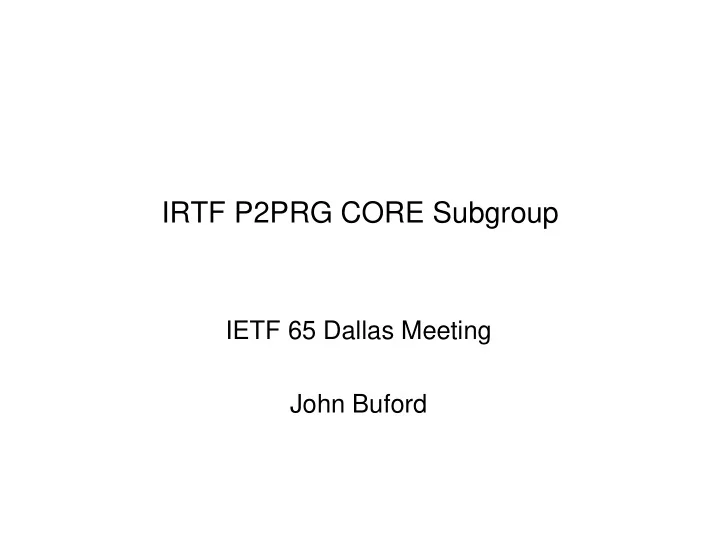

IRTF P2PRG CORE Subgroup IETF 65 Dallas Meeting John Buford
CORE Subgroup (Content, Resource, and Service Discovery) • Deliverables (from charter) – Problem statement (completed) – Survey of related work (underway) – Experimental plan – Experimental results • Problem Statement – draft-irtf-p2prg-core-problem-statement-00.txt – John Buford, Keith Ross, Mario Kolberg • Purpose – Define a research agenda – Attract participation from other researchers interested in these problems and develop a coordinated research approach within the P2PRG CORE subgroup.
CORE Subgroup (Content, Resource, and Service Discovery) • Research Issues – Global Scale Service Discovery – Service-Oriented Overlays – Internet Infrastructure Uses – Content and Resource Discovery / Search • Examples – M. Balazinska, H. Balakrishnan, D. Karger. INS/Twine: A Scalable Peer-to-Peer Architecture for Intentional Resource Discovery. Pervasic Computing 2002. – C. Schmidt and M. Parashar, A Peer-to-Peer Approach to Web Service Discovery , World Wide Web Journal, Vol. 7, Issue 2, June 2004 – John Buford, Alan Brown, Mario Kolberg. Meta Service Discovery. 3 rd IEEE International Workshop on Mobile Peer-to-Peer Computing (MP2P'06)
CORE Subgroup (Content, Resource, and Service Discovery) • Problem statement - feedback on email list – Some suggestions about definition section – Different ways of classifying P2P systems (taxonomy) • Next steps – Update problem statement draft based on feedback
CORE Subgroup (Content, Resource, and Service Discovery) • Deliverable 2: Survey of related work • Preliminary outline (see subsequent slide) • Looking for volunteers to contribute sections
CORE Subgroup: Deliverable 2: Survey of Related Work • Approach – Avoid repeating discussions found already in surveys of P2P overlays (so cite heavily) – Create a document that can cover (through contributions from others) many more systems than one usually finds in papers. – Some organizing principle should be followed, like the architecture taxonomy in previous slides, or Aberer et al's design space – Perhaps each P2P overlay should be summarized in a table format for comparison
CORE Subgroup: Deliverable 2: Survey of Related Work Possible outline: I. P2P Overlay Network Architecture III. Service Description Format A. Topology Taxonomy IV. Group Mechanism Structured, Unstructured, Hybrid, V. Performance Hierarchical VI. Summary Tables B. Functional Taxonomy Filesharing, VoIP, Service II. P2P Service Overlay A. Layered (e.g., INS/Twine on Chord) B. Integrated into Routing (e.g., semantic routing) C. Federated (supporting multi discovery methods)
Recommend
More recommend